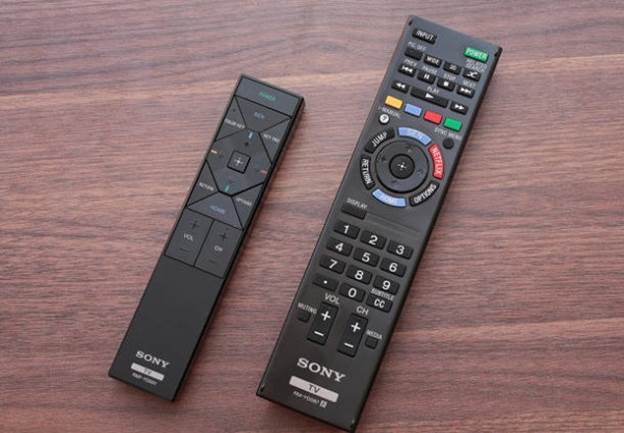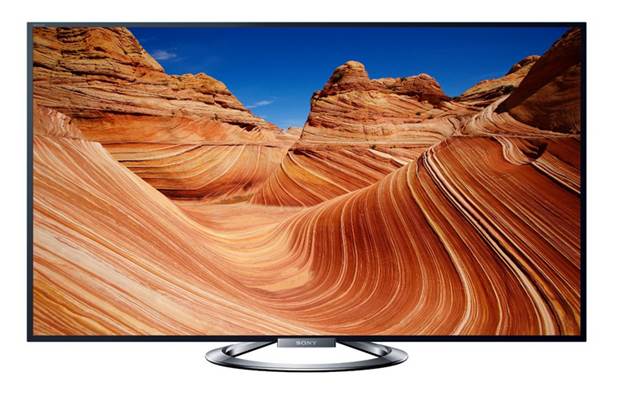With Sony’s
LED Dynamic Control (for the edge-lit local dimming) set to Standard, the black
level was unmeasurable with a full-screen black image. But it increased
significantly when this feature was turned off. Unlike multiple zone backlit
local dimming, however, with edge-lit local dimming, a spot of light on the
dark screen, such as the pause bug generated in the upper left corner by our Oppo BD player, turns on the edge lighting in the affected
area. This produces a gray band extending completely across the screen from
left to right. But this was obvious only on an otherwise fully black screen; on
typical source material, the gray banding was rarely noticeable.

Sony’s remote is fairly streamlined for an HDTV
wand
The recent
Sony 4K sets we’ve tested had this same gray banding effect, but on those
models the edge lighting was located at the top and bottom of the screen and
the banding was vertical. In the KDL-65W850A, the edge lighting is on the
sides. One benefit to the latter is that the side lighting with local dimming
is superior to top and bottom lighting in keeping the black bars dark on
widescreen movies.
While
calibration measurably improved our sample, the set was more than satisfactory
out of the box in the Cinema 2 mode and the Warm 2 Color Temperature setting
(the so-called Neutral Color Temperature selection isn’t even close to the D65
standard). But I still recommend a good calibration; there’s no way for us to
know if every sample off the production line will be as close to being on the
money, prior to calibration, as ours.
Animation
has its limitations as a source for judging the naturalness of an image, but
it’s great for evaluating resolution. And no animation studio puts more detail
in its films than Pixar. Monsters University is a much better film than it’s
been given credit for, but regardless of where it falls in the Pixar Hall of
Fame, it’s a standout for the textures and detail given to its characters and
backgrounds. The Sony appears to get it all, and it’s hard to imagine this
movie looking better than it does on this set. The color is extremely rich and
vivid as well – even if we’re talking about computer-generated color.

Connections are located in a recessed area on
the back panel
Samsara is
a live-action documentary styled in the same fashion as Baraka and produced by
the same team of filmmakers. The Blu-ray is clearly reference quality (the film
was shot in 70mm), with scenes that segue from jaw-droppingly
gorgeous (the interiors of Versailles and St. Peter’s, Tibetan sand art) to
strange (the trio of dancers that open the film), to downright repulsive (you
might never want to eat chicken again). Through it all, however, the Sony
doesn’t miss a step in delivering not only the film’s bizarreness, but also all
of its ravishing color and detail.
The Sony’s
black level and shadow detail are impressive as well. I wasn’t at all let down
by its handling of Harry Potter and the Deathly Hallows: Part 2 – a film that’s
nearly one long black-level killer test from beginning to end. It did send me
to the Sony’s menu to make some minor changes (no more than a single step to
Brightness and Gamma), but I arrived at a very satisfying result. And if that
result was never quite as flawless as I see from the best plasma sets, it was
close. Sony (and other manufacturers as well) has made real strides in
improving the LED edge-lit local dimming on their LCD designs, though
full-array LED backlighting with local dimming remains the gold standard for
producing compelling LCD blacks.

A viewing position more than 25 degrees to the
side
The one
remaining serious weakness in most LCD designs is off-center viewing, and
that’s the case here. Move more than 15 degrees to the side on this Sony, and
the image starts to wash out and lose contrast. At a viewing position more than
25 degrees to the side (or significantly above or below the screen) no videophile will be satisfied with the picture for long –
though non-critical, casual viewers probably won’t notice. If you’re reading
this, however, you may be in the purist camp and will want to sit as close to
the center of the screen as possible.
3D, if You Must
It’s been
said that 3D is losing its market mojo. That may be true, but if you must go
3D, the Sony is definitely above average. As measured through its active
glasses, its post-calibration brightness of just under 12 foot-lamberts (Standard
Picture Mode, with the 3D Glasses Brightness set to High), it’s pleasingly
bright – brighter than many 3D sets but not the brightest we’ve seen. (The
latter include other Sony’s we’ve recently tested, particularly their Ultra HD
sets that employ passive glasses.) I did see some ghosting, but mainly on white
titles and subtitles. Post-calibration, there was also some bluishness visible
in black areas without the 3D glasses, but the glasses effectively filtered
this out.
I also
noticed some motion judder in 3D, particularly in chapter 3 of Captain Americaas the camera pans across the Alps near Red Skull’s
lair. There was also some flicker on the stationary opening menu of Pacific
Rim. Turning on Motionflow and selecting its Standard
setting eliminated both of these issues. They were rare enough that I preferred
to do without the look of Motionflow. But if the
judder and flicker bother you in 3D, Motionflow is
the best available solution.